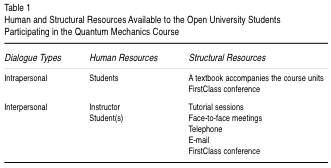
VOL. 21, No. 3, 1-22
This study investigated the kinds of dialogic behavior engaged in by students while studying a difficult physics course at the Open University, UK. Research objectives were twofold: (1) to document what dialogue types, mediated through which resources, were utilized by students to overcome conceptual difficulties that emerged while reading the course materials and while solving difficult Tutor Marked Assignments and (2) to correlate dialogic behaviors with several student attributes (age, gender, motivation to achieve a high grade, learning preference and a prior acquaintance with at least one other student in the course). Two main findings emerged: (1) initially, a large majority of students dealt with both kinds of difficulty individually; only when such efforts failed did they turn to interpersonal dialogue and (2) a very large majority of students turned to instructors for help, not to their peers. The first finding replicated those from previous studies while the second finding differed from previous ones wherein students turned overwhelmingly to peers, not to instructors.
Cette étude examine les types de comportements dialogiques dans lesquels les étudiants se sont engagés en étudiant pour un cours de physique difficile à la Open University de Grande-Bretagne. Les objectifs de recherche étaient de deux ordres : 1) documenter quels types de dialogues, à travers quelles ressources, ont été utilisés par les étudiants pour surmonter les difficultés conceptuelles qui ont émergé durant la lecture du matériel de cours et durant la réalisation de travaux difficiles notés par les tuteurs, et 2) faire la corrélation entre les comportements dialogiques et plusieurs attributs des étudiants (âge, sexe, motivation à obtenir une bonne note, style d'apprentissage et une connaissance préalable d'au moins un autre étudiant du cours). Deux résultats se sont imposés : 1) au départ, une grande majorité d'étudiants ont d'abord tenté de résoudre les deux types de difficultés seuls, et seulement quand ces efforts se sont avérés infructueux se sont-ils tournés vers un dialogue interpersonnel, et 2) une très grande majorité d'étudiants se sont tournés vers le formateur pour les aider, pas leurs pairs. Le premier résultat reproduisait celui d'études antérieures alors que le second différait largement de résultats antérieurs où les étudiants, en grande majorité, se tournaient plutôt vers leurs pairs, pas le formateur.
This article recounts a research study aimed at exploring individual accounts of the process of learning a difficult, advanced level university course in physics by focusing on the instructional dialogues and resources utilized by distance education students at the Open University, UK. Of particular interest was the nature of the interpersonal dialogues that occurred. In previous studies (described below), where course difficulty was perceived as low or moderate, it was found that a large majority of students turned to peers for help, not to instructors. In this study, it was hypothesized that tutors would be the primary source for addressing difficulties, either the inability to understand subject matter or the inability to solve difficult Tutor Marked Assignments. This hypothesis is based on the assumption that students will not be able to help one another since nearly all would be experiencing similar difficulties.
Today, modern instructional systems (campus-based as well as distance) include a diverse array of resources for intrapersonal dialogue (individual study) such as self-instruction texts and multi-faceted Web-based instructional systems. In addition, there are various resources for interpersonal dialogue (instructor-student, student-student) such as face-to-face meetings, e-mail, telephones and websites for both synchronous and asynchronous interaction. To view instructional systems in terms of dialogues and resources, however, requires a broad conceptual framework of distance education systems that recognizes the centrality of instructional dialogue. Such a framework originated as a theory of distance education (Gorsky & Caspi, 2005) and has subsequently evolved into a unified theory of instruction in the cognitive domain (Gorsky, Caspi & Chajut, in press). In order to proceed, a brief review of the framework is necessary.
The framework rests on one assumption: Instruction = Dialogue; three propositions are derived from this assumption:
The differences between intra- and interpersonal dialogues are especially important for the current discussion.
Intrapersonal dialogue is defined formally as the interaction between student and subject-matter that occurs when, and only when, it is mediated by a given instructional resource. Any instructional material of any kind specifically and intentionally made available to students for intrapersonal dialogue is a structural resource. For example, when students read books or text from computer screens, listen to lectures or to dialogues engaged in by others, use computer simulations or watch educational television with the intent to learn, they are engaging in intrapersonal dialogue.
Intrapersonal dialogue is defined operationally in terms of practical, quantifiable variables relevant to students studying alone. For example, vis-à-vis the structural resources utilized for the intrapersonal dialogues, we list the following variables:
Regarding the human resources utilized for the intrapersonal dialogues, only one, the student, is of relevance. Each student utilizes structural resources as he or she sees fit in accord with his or her age, prior knowledge, motivation, learning styles and perceived course difficulty. These variables differ for each learner and they determine the extent of intrapersonal dialogue that occurs and its quality. Groups of students, too, may be characterized by these same variables which should be taken into account by instructional designers.
Students, of course, may interact with subject-matter without the presence of any given resource. In fact, this may be a desirable instructional outcome indicating “deep-level” learning (Marton & Saljo, 1976; Biggs 1987) or “reflective learning” (Hoban, 2000) or "critical thinking" (Garrison, 1992). This interaction, however, is not defined as intrapersonal dialogue which, within the domain of the instructional framework, deals only with quantifiable resources and behavior. The internal mental processes that presumably occur during intrapersonal dialogue lie within the domain of learning theory.
Interpersonal dialogue is defined formally as the interaction between instructor and student or between student and student. It may be face-to-face or mediated by communications media; if mediated, synchronous or asynchronous (Gorsky & Caspi, 2005). Interpersonal dialogue is defined structurally as a message loop between Instructor-Student-Instructor or Student-Instructor-Student or Student A-Student B-Student A. Students may, of course, engage in dialogues with significant others such as parents, friends or employers. These human resources are excluded since they are beyond the domain of instructional systems. Typologically, interpersonal dialogue has two distinct classes of outputs: subject-matter oriented and non-subject-matter oriented. One or both types may characterize a message.
It has been found that three structural resources determine to a large degree the extent of interpersonal dialogue that may occur in an instructional system.
Instructors and students are the human resources associated with interpersonal dialogue. Instructors, characterized by “conceptions of teaching” (e.g., Kember, 1997; Prosser, Trigwell and Taylor, 1994) and “facilitation skills” (e.g., Bruner, 1966; Rogers, 1969), play a critical role in creating and maintaining dialogue in the classroom, be it traditional or virtual. Students, characterized by learning preferences, especially "autonomy" (Moore, 1993; Caspi and Gorsky, 2006), and by the need to overcome conceptual difficulty or to solve an insoluble problem (Gorsky, Caspi & Tuvi-Arad, 2004; Gorsky, Caspi & Trumper, 2004, 2006) engage in interpersonal dialogue to greater or lesser degrees. Furthermore, it was found that students' first partner choice for interpersonal dialogue correlated with “prior acquaintance with a fellow student”; that is, students who knew other students turned to them first (Caspi & Gorsky, 2006).
Three examples follow that illustrate how study strategies and practices used by students may be viewed and analyzed in terms of the dialogues they engage in and the resources that make the dialogues possible.
Concluding Remarks About the Theoretical Framework
Beyond creating capabilities for mapping students' dialogic behavior, the ultimate goal of the theoretical framework is to determine universally valid “Global Reference Points” for the design of instructional systems in the cognitive domain (Gorsky, Caspi & Chajut, in press). These global reference points (group size, instructional strategy, instructor accessibility, etc.) will be benchmarks for making top-down strategic decisions with confidence. In this sense, the framework is a meta-theory of instructional design.
The end product will be a finite and fairly complete set of rules linking the initial conditions of instructional systems to dialogic behavior, and dialogic behavior to learning outcomes. We suggest that the widespread use of the framework's variables will end the “ Tower of Babel Syndrome” (Guri-Rosenblit, 2001) thereby enabling researchers to work from a common frame of reference with a common set of variables toward a common goal.
To date, this theoretical approach has been used to track distance and campus-based students' dialogic behavior in three preliminary small-scale naturalistic studies (Gorsky, Caspi & Tuvi-Arad, 2004; Gorsky, Caspi & Trumper, 2004, 2006) and in one larger scale study (Caspi & Gorsky, 2006). The small-scale studies (n ≤ 14) were based on interview data obtained from undergraduate students as they learned physics and chemistry. The larger scale study (n = 521) was based on data obtained from an electronic questionnaire from undergraduate distance education students studying diverse courses.
Several findings emerged from the naturalistic studies. First, it was found that all activities engaged in by students could be categorized as dialogues that were enabled by some structural resource. Second, a general approach to the use of dialogue was discerned. For all students participating in these studies, intrapersonal dialogue was the primary and preferred study mode. This finding is supported by several other research studies such as Rourke et al. (1999) and Rourke & Anderson (2002). Distance students learned individually primarily from self-instruction texts and tutorials while campus-based students learned individually at lectures and tutorials. At large lectures (in the study cited above, group size was about 150 students per lecture), few students actually engaged in interpersonal instructor-student dialogue. Only for campus-based students participating in small introductory level courses (about 10 registered students) was interpersonal dialogue a significant mode while learning in the classroom. Third, both distance and campus-based students opted for interpersonal dialogue only when they could not solve the assigned problems. Fourth, and last, for nearly all students, the primary partner for interpersonal dialogue was other students and peers. Instructor-student dialogues were generally used as a last resort.
These findings are, to say the least, not surprising. What we believe important, however, is that these unsurprising and familiar findings may now be grounded in a unified theoretical framework of instruction. The second finding illustrates clearly the impact of group size and instructional strategy on dialogic behavior. Group size and attributes (age, goals, motivation, etc.) limit the kinds of instructional strategies that may be usefully employed. In turn, instructional strategy determines to a very large extent the type, amount and duration of in-class interpersonal dialogue that occurs.
Finding three illustrates clearly the tension between some instructional theories on the one hand and practices engaged in by students on the other. Some general theories of instruction, such as those advanced by Bruner (1966) and Rogers (1969), and some theories of distance education (Moore, 1993; Garrison & Anderson, 2003), often assign to interpersonal dialogue, especially between teacher and student, an importance that may not be realized in practice. In the studies cited above, interpersonal teacher-student dialogue appeared limited to dealing with specific difficulties raised by students.
The larger scale study (Caspi & Gorsky, 2006) supported these findings vis-à-vis distance education students studying courses from a wide range of disciplines, not just science. This research agenda typifies a grounded theory approach (Glaser, 1978; Glaser & Strauss, 1967; Strauss & Corbin, 1998) that begins with small naturalistic studies. Naturalistic studies generate models and hypotheses that can then be tested on larger populations using traditional statistical procedures. Taber (2000) wrote that “grounded theory may be used to bridge between case studies and large-scale surveys, which enables the strengths of both to be combined in the same research programme” (p. 470).
Objective and Research Questions
The objective of the present study is to expand our understanding of students' dialogic behavior in a course generally perceived as difficult. Three research questions were formulated:
Hypotheses
Four hypotheses were formulated:
Hypotheses 1-3 attempt to replicate findings from the previous small- and large-scale studies with Israeli students. In replication studies, it is acceptable to test the validity of a null hypothesis.
Dr. Robert Lambourne, former chairman of the Department of Physics at Open University, UK, suggested the fourth hypothesis. He noted that that in a very difficult course such as quantum mechanics, peers would be unable to help one another since nearly all would be experiencing similar difficulties. If so, such a finding would help clarify the impact of the variable "perceived course difficulty" on students' dialogic behavior.
Background
The Quantum Mechanics course from which participants were surveyed is an advanced level course required of all physics majors at Open University, UK. It accounts for 30 credits out of a total 360 needed for graduation. The duration of the course is nine months.
The course is written and maintained by a course team at the University. This is a group of about 4-5 people who, once a course is written and produced, write the assignment questions and examination each year and field queries that come from part time Associate Lecturer (AL) staff or staff in Student Services departments who take queries from students. Each student who registers for the course is assigned to an AL and each AL has about 20 students per course.
There are an average of three to four 2-hour-long tutorials per course and usually one or two dayschools during the year. These are all staffed by the ALs — for tutorials the students would normally go to their own AL's session; dayschools may have several ALs available. Tutorials usually involve discussion of the course materials, problem-solving and a review of the previous Tutor Marked Assignment (TMA). Rarely, there is a mini-lecture but this is not standard. Tutorials are optional and generally less than 50% of the students attend on average. There are 4 TMAs for the course which make up 50% of the final grade, the remaining 50% being from an exam.
All students also have access to what is called “FirstClass computer conferencing”. For SM355 Quantum Mechanics, the Students' Association ran the conference, not the course team. This means that it wasn't systematically mediated by either full time University staff or AL staff, though several of them no doubt looked in. Newer courses, including the new QM course to be released in 2007, have conferences run by the course team. The conference is open to all, but the students have to actively seek out the conference whereas course team run conferences will appear automatically on the students' desktops.
Students are given their tutor's ( AL's) contact details and each student received a letter from his or her AL with information about frequency of contact, best times to phone, etc. Students attending the tutorials put their contact details on a paper going around the room so that they could form a “self help group” of peers to phone/email/meet.
Students also get information about who to contact with what sort of queries. ALs are available really at any time for academic queries and students can expect email responses within a day or two. It is basically up to the student to form links with peers, aside from using the conference which is available 24 hours per day. Queries to the course team can be sent and will be responded to, but this is usually a last port of call for most students and often such queries will be directed via the tutor.
Table 1 lists the human and structural resources available to students in the course and the dialogues associated with these resources.
In this study, "instructor" is the term used for the person who communicated with students in tutoring sessions, by e-mail, by telephone or in person.
Participants
All 355 students in the course Quantum Mechanics were sent written questionnaires posted to their home addresses. A total of 124 students returned completed or nearly completed questionnaires. Since this study investigates the dialogic behavior of students in a course perceived as “difficult”, the three respondents who perceived the course as being “easy” or “very easy” were excluded from the sample. Demographic data appear in Table 2.

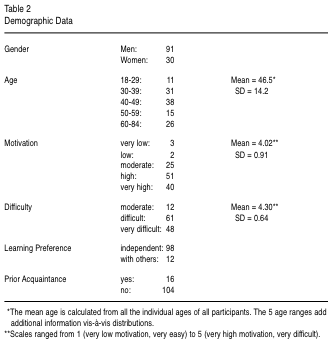
Data Collection
The use of dialogue and resources was investigated through a “Tactical Approaches to Study” questionnaire, (See Appendix A). The first six questions elicited certain student attributes: age, gender, motivation, perceived course difficulty, learning preference (alone or with others) and prior acquaintance with a student in the course. The following questions elicited from students their dialogic behavior. Students were asked to record all actions undertaken to overcome difficulty encountered while reading course materials, and the resources they utilized to do so. Finally, they were asked to rate the perceived relative contributions made by each action. We repeated this procedure for the Tutor Marked Assignments (TMAs).
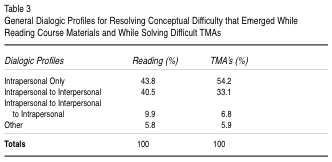
Findings are presented in the order that the research questions and hypotheses were presented. Some preliminary discussion, directly related to specific findings, is juxtaposed for the reader's convenience.
Students' Dialogic Behavior (Research Question 1, Hypotheses 1a-c)
Table 3 summarizes the general dialogic profiles that emerged from the data analysis.
The first three profiles, which characterize 94.2% of the students, are clear-cut. They indicate that students initially tried to overcome difficulty on their own. Only when these efforts failed did they turn to others for help. These findings clearly support Hypotheses 1a and 1b.
Furthermore, in clear support of Hypothesis 1c, the reported dialogic behaviors were similar in both instances. A Chi-Square test showed no significant difference [ c 2 (3) = 4.42, p = 0.22] between profiles for addressing difficulty that emerged while reading course materials and while solving difficult TMAs.
These general profiles tell us nothing about the specific resources utilized for addressing conceptual difficulty. Table 4 lists the dialogues engaged in alongside the resources utilized for addressing conceptual difficulties that emerged while reading the course materials. Resources labeled "other" were structural resources for intrapersonal dialogue not listed in the questionnaire (e.g., internet, study previous exams), but cited by students. A similar analysis was carried out for resource utilization while solving difficult TMAs. Again, differences were negligible.
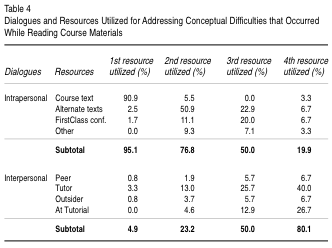
The movement from intrapersonal dialogues to interpersonal ones is reflected most clearly in the “subtotal” rows. Furthermore, texts were the preferred resources utilized for the intrapersonal dialogues that addressed conceptual difficulty. Only after these intrapersonal courses of action failed to resolve conceptual difficulty did students turn to interpersonal dialogue, primarily with the tutor.
Fifty-six students reported that they learned independently; that is, they sought no help or advice from anyone. Sixty-five students engaged in some form of interpersonal dialogue when confronted with conceptual difficulty. First partner choices follow: 76.9% chose the tutor (either personally or at a tutorial), 10.8% chose a peer and 12.3% chose an outside source. Again, differences between these findings and those for first partner choice vis-à-vis solving difficult TMAs are negligible.
Figure 1 represents the dialogic behavior exhibited by students as a simple algorithm.
These findings replicated those from the studies cited above. Indeed, this behavior pattern is the paradigm of Open Universities everywhere.
Furthermore, students' dialogic behaviors while confronting conceptual difficulty did not differ significantly from those exhibited while solving difficult TMAs. This consistency in dialogic behavior also replicates findings from the previous studies cited above (Gorsky, Caspi & Tuvi-Arad, 2004; Gorsky, Caspi & Trumper, 2004, 2006; Caspi & Gorsky, 2006).
There is a large body of psychological research dealing with cross-situational behavioral consistency, namely, whether or not people behave in the same manner across different situations (see: Funder and Colvin, 1991). It is assumed that behavioral consistency reflects an essential attribute of personality. Thus, dialogic behavior associated with learning may be seen, at least in part, as a reflection of a student's personality. This finding reinforces the theoretical assertion regarding the centrality of student traits and attributes vis-à-vis their dialogic behavior.
Demographic Data and Dialogic behavior (Research Question 2, Hypotheses 2-3)
In support of Hypothesis 2, a null hypothesis, Chi-square tests showed no relation among students' three explicitly defined types of general dialogic behavior (see Table 3: intrapersonal only, intrapersonal then interpersonal, intrapersonal to interpersonal to intrapersonal) and gender c 2 (2) = 0.58, p = 0.75], age [ c 2 (4) = 2.30 p = 0.68], motivation to achieve a high grade [ c 2 (4) = 4.54 p = 0.34], learning style [ c 2 (2) = 4.87 p = 0.09] or having a prior acquaintance with a fellow student [ c 2 (2) = 4.56 p = 0.10].
Again, these findings replicate those from previous studies. In other words, adult, distance-education, Open University students tend to study alone. Only when confronted with some difficulty, do they turn to others for help.
In support of Hypothesis 3, a relationship was found between prior acquaintance with a fellow student and first partner choice for overcoming difficulty while reading course materials. Data appear in Table 5. A very similar distribution was obtained for first partner choice
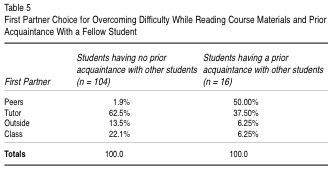
to help solve difficult TMAs. In other words, students having a prior acquaintance with another student were more likely to turn to a peer rather than to the tutor for assistance.
The correlation between “prior acquaintance with peers” and dialogic behavior seems straightforward and meaningful: students who know other students speak with them. If so, and if such relationships help students learn, then organizational steps may be taken by both campus-based and distance-education universities to help students become acquainted with each other prior to, or at the start of a course or program. Instructors might actively encourage students to participate in study groups, be they face-to-face or virtual. Furthermore, virtual forums, both synchronous and asynchronous, should be set up and their use actively encouraged.
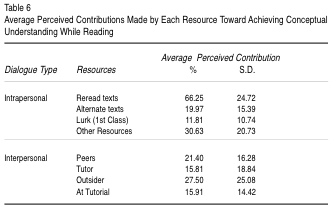
Overcoming Conceptual Difficulties and Solving Difficult TMAs (Research Question 3, Hypothesis 4)
The Perceived Importance of the Tutor
Table 6 summarizes students' perceptions of the relative contribution made by each resource toward achieving conceptual understanding.
The effect for the different resources is significant: F(7,321) = 63.39,
p < 0.001; h 2 = .58. To clarify this effect, a Scheffé post-hoc test was carried out; significant differences between rereading texts and all other resources (which did not differ significantly among themselves) were found. To further understand the perceived contributions made by each resource, Table 7 presents the distributions of the perceived contributions made by each resource for overcoming conceptual difficulty encountered while reading the course materials.
Clearly, intrapersonal dialogues, mediated primarily by rereading course materials, appeared to make the most significant contribution toward overcoming conceptual difficulties. The perceived contributions made by all other resources appear to be negligible. Of particular interest is the low perceived contribution made by the tutor. Thirty students reported that the tutor's perceived contribution toward overcoming conceptual difficulty was 10% or less.
These findings will be discussed from two perspectives: first partner choice for interpersonal dialogue and perceived contribution made to understanding subject matter and to solving problems.
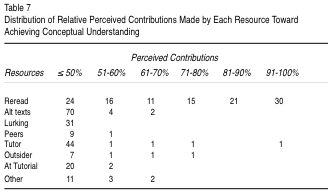

First Partner Choice
In this difficult physics course, tutors were the overwhelming first-partner choice in interpersonal dialogue. Peers and outside sources were utilized sparsely. These findings differ from all the previous ones cited above where peers were the preferred first partners in interpersonal dialogue.
Based on the findings from this study alone, however, we cannot yet make the following generalization that for courses generally perceived as difficult, the preferred partner for interpersonal dialogue is the tutor. This is so because the previous findings in which peers were the preferred first partners came from four studies with Israeli students. Only further studies with UK students participating in courses perceived as easy will clarify the issue.
Perceived Contribution for Understanding Subject Matter and for Solving Problems
Here, we try to evaluate what dialogue types and which resources led to the successful resolution of difficulties. Table 8 shows three typical student dialogic profiles for overcoming conceptual difficulty that emerged while reading course materials along with their perceived contribution. From these data, a philosophical question emerges, namely, to which dialogue types and to what resources should credit for achieving understanding be assigned?
In the first profile, should credit be assigned to Student A who reported attaining 91% understanding through three instances of intrapersonal dialogue or to the tutor who accounted for the final 9%. Clearly, the first three dialogues accounted for most of the understanding, but not all. Without the tutor's help, however, the conceptual difficulty would not have been overcome. For Students B and C, similar dilemmas exist.
It is clear that students attributed most of the perceived contribution made to overcoming conceptual difficulty to themselves. However, despite the low perceived contributions attributed to tutors, it seems clear that they provided help at critical junctions for those who sought help, and those who sought help were a majority of the students. Such behavior, an indication that human cognition is biased, has been widely reported for decades by researchers from various disciplines. For example, Heider (1976) observed that "one is inclined to attribute to oneself good things, but one suffers when one has to attribute to oneself something that is not good" (p. 16). More recently, Mezulis et al. (2004) noted that "people seek a positive image of themselves and their environments with such vigor that reality at times is selectively interpreted and at other times patently ignored" (p. 711).
In this section, we attempt to place the findings, together with issues raised in the preliminary discussion, into a broader perspective vis-à-vis the theoretical framework of instructional dialogue. In addition, we provide practical benchmarks for instructional designers.
As discussed previously, the ultimate goal of the theoretical framework is to determine universally valid “Global Reference Points” for the design of instructional systems in the cognitive domain. These reference points (e.g., age, group size, instructional strategy, course difficulty, etc.) will be the benchmarks for making top-down strategic decisions with confidence; that is, the reference points are valid for all kinds of instructional designs, be they grounded in constructivist or instructivist theories. The findings from this study take us one small step further toward that goal. We wish to reiterate that no startling, heretofore unknown discoveries have emerged. Each “global reference point” is familiar, unsurprising and even reassuring (we have learned a great deal about teaching and learning over the past 3,000 years). What we believe important, however, is that these heretofore anecdotal and unrelated truisms are now grounded and linked in a unified theoretical framework as dialogues and resources that support dialogue. The following section deals with integrating findings from this study and others cited above into the framework.
Course Difficulty
It appears that “course difficulty” (however it is ultimately defined) has a significant impact on students' dialogic behavior. In this study, we found that Open University, UK, students turned to tutors for help when faced with an unresolvable difficulty. In the previous studies cited above, Israeli students in moderately difficult courses turned primarily to peers for help. Further research is required to more fully understand the relation between course difficulty and dialogic behavior. Several scenarios, vis-à-vis adult students in undergraduate science courses, have emerged from our empirical research:
These may be universal phenomena or culturally biased ones. Further research will provide answers. In practical terms, such answers may help us to optimize instructional systems in terms of course difficulty/class size. On the one hand, if instructor-student dialogues are limited in "easy" courses (as our previous findings have indicated), then a large class size is feasible and justifiable, both from economic and pedagogical points of view. On the other hand, if levels of instructor-student dialogue are high in "difficult" courses (as these findings indicate), then a small class size is feasible and justifiable, both from economic and pedagogical points of view (a higher rate of student success along with a reduction in dropout rates may be attained given a higher level of instructor presence).
From the perspective afforded by the theoretical framework, it appears that the variable "course difficulty" is a “global reference point” that should be taken into account by instructional designers, whatever their theoretical bias.
Before rushing off to change instructor/student ratios, however, an understanding of why a course is difficult should be achieved. For example, findings from this and other studies show that adult students learn alone and deal with difficulty initially on their own. This finding has practical implications. First, given a “difficult” course, instructional designers should evaluate carefully the quality of the instructional materials from which students are expected to learn. If too large a percentage of students (whatever that agreed upon percentage is) do not understand the concept at hand because the instructional materials are at fault, then the course materials should be revised or replaced. Such an approach should facilitate student achievement and decrease the workload experienced by instructors.
We analyzed how Open University UK students participating in a difficult advanced level quantum mechanics course dealt with conceptual difficulties that emerged while reading course materials and while solving difficult Tutor Marked Assignments. It was found that a large majority of students initially dealt with both kinds of difficulty individually, on their own, primarily through the use of texts; this behavior was defined as intrapersonal dialogue. Only when such efforts failed did they turn to interpersonal dialogue. Furthermore, a very large majority of students turned to instructors for help, not to their peers. The first finding replicated those from previous studies with Israeli Open University students while the second finding differed from previous ones also with Israeli students who turned overwhelmingly to peers, not to instructors.
Biggs, J. (1987). Student approaches to learning and studying. Melbourne, Australian Council for Educational Research.
Bruner, J. (1966). Toward a theory of instruction. Cambridge, MA: Harvard University Press.
Caspi, A., Gorsky, P., & Chajut, E. (2003). The influence of group size on non-mandatory asynchronous instructional discussion groups. The Internet and Higher Education, 6(3), 227-240.
Caspi, A., & Gorsky, P. (2006). The dialogic behavior of Open University students. Studies in Higher Education, 31(6), 735-752.
Chen, Y., & Willits, F. (1998). A path analysis of the concepts in Moore's theory of transactional distance in a videoconferencing learning environment. The American Journal of Distance Education, 13(2), 51-65.
Chen, Y. (2001a). Transactional distance in World Wide Web learning environments. Innovations in Education and Teaching International, 38(4), 327-338.
Chen, Y. (2001b). Dimensions of transactional distance in World Wide Web learning environment: A factor analysis. British Journal of Educational Technology, 32(4), 459-470.
Clark, R. (1983). Reconsidering research on learning from media. Review of Educational Research, 53, 445-460.
Connor, K, & Day, R. (1988). Class size: When less can be more. Sacramento, CA: Senate Office of Research, State of California.
Draper, S., Brown, M., Edgerton, E., Henderson, F., McAteer, E., Smith, E., & Watt, H. (1994). Observing and measuring the performance of educational technology. Glasgow UK: University of Glasgow Press.
Funder, D. C., & Colvin, C. R. (1991). Explorations in behavioural consistency: Properties of persons, situations, and behaviours. Journal of Personality and Social Psychology, 60(5), 776-794.
Garrison, D.R. (1992). Critical thinking and self-directed learning in adult education: an analysis of responsibility and control issues. Adult Education Quarterly, 42(3), 136-148.
Garrison, D., & Anderson, T. (2003). E-learning in the 21st century. London, Routledge.
Garrison, D.R., & Cleveland-Innes, M. (2006). Facilitating cognitive presence in online learning: Interaction is not enough. American Journal of Distance Education. (In Press).
Glaser, B. (1978). Theoretical sensitivity: Advances in the methodology of grounded theory. Mill Valley, CA, The Sociology Press.
Glaser, B., & Strauss, A. (1967). The discovery of grounded theory: Strategies for qualitative research. New York: Aldine de Gruyter.
Glass, G., & Smith, M. (1978). Meta-Analysis of research on the relationship of class-size and achievement. San Francisco, CA: Far West Laboratory for Educational Research and Development.
Glass, G., & Smith, M. (1979). Relationship of class size to classroom processes, teacher satisfaction and pupil affect: A meta-analysis. San Francisco, CA: Far West Laboratory for Educational Research and Development.
Gorsky, P., & Caspi, A. (2005). Dialogue: A theoretical framework for distance education instructional systems. British Journal of Educational Technology, 36(2), 137-144.
Gorsky, P., Caspi, A., & Tuvi-Arad, I. (2004). Use of instructional dialogue by university students in a distance education chemistry course. Journal of Distance Education, 19(1), 1-19.
Gorsky, P., Caspi, A., & Trumper, R. (2004). Dialogue in a distance education physics course. Open Learning, 19(3), 265-277.
Gorsky, P., Caspi, A., & Trumper, R. (2006). Campus-based university students' use of dialogue. Studies in Higher Education, 31(1), 71-87.
Gorsky, P., Caspi, A., & Chajut, E. (in press) Instructional dialogue: Toward a unified theory of instruction in the cognitive domain. In: Zheng, R. & Pixy-Ferris. S. (Eds.) Understanding online instructional modeling: Theories and practices. Hershey, PA: Idea Group, Inc.
Guri-Rosenblit, S. (2001). The Tower of Babel Syndrome in the discourse on information technologies in higher education. Global E-Journal of Open and Flexible Learning, (1), 28-38.
Heider, F. (1976). A conversation with Fritz Heider. In J.H. Harvey, W.J. Ickes, and R.F. Kidd (Eds.). New directions in attribution research (Vol. 1, pp. 47-61). Hillsdale, NJ: Erlbaum.
Hoban, G. (2000). Using a reflective framework to study teaching-learning Relationships. Reflective Practice, 1(1), 165-182.
Kearsley, G., & Shneiderman, B. (1998). Engagement theory: A framework for technology-based teaching and learning. Educational Technology, 38(5), 20-23.
Kember, D. (1997) A review and reconceptualization of the research into academics conception of teaching. Learning and Instruction, 7(3), 255-275.
Marton, F., & Saljo, R. (1976) On qualitative differences in learning: 1. Outcome and process. British Journal of Educational Psychology, 46, 4-11.
Mezulis, A., Abramson, L., Hyde, J., & Hankin, B. (2004). Is there a universal positivity bias in attributions? A meta-analytic review of individual, developmental and cultural differences in the self-serving attributional bias. Psychological Bulletin, 130(5), 711-747.
Moore, M. (1993). Theory of transactional distance. In D. Keegan (Ed.), Theoretical principles of distance education. New York: Routledge, 23-38.
National Education Association. (1986). What research says about class size. Wash. DC: Professional and Organizational Development/Research Division.
Prosser, M., Trigwell, K., & Taylor, P. (1994). A phenomenographic study of academics' conceptions of science learning and teaching. Learning and Instruction, 4, 217-232.
Rogers, C. (1969). Freedom to learn. Columbus: Merrill Publishing Co.
Rourke, L., Anderson, T., Garrison, D., & Archer, W. (1999). Assessing social presence in asynchronous text-based computer conferencing. Journal of Distance Education, 14(2), 50-71.
Rourke, L. & Anderson, T. (2002). Exploring social presence in computer conferencing. Journal of Interactive Learning Research, 13(3), 259-275.
Strauss, A., & Corbin, J. (1998). Basics of qualitative research: Techniques and procedures for developing grounded theory. Thousand Oaks, CA: Sage Publications.
Taber, K. (2000) Case studies and generalizability: Grounded theory and research in science education. International Journal of Science Education, 22, 469-487.
Word, E., Johnston, J., Bain, H., Fulton, D., Boyd-Zaharias, J., Lintz, M., Achilles, C., Folger, J., & Breda, C. (1990). Student/Teacher Achievement Ratio (STAR): Tennessee's K-3 class-size study. Nashville: Tennessee State Dept. of Education.
Paul Gorsky is a Research Associate in the Chais Research Center for Instructional Technologies and a Course Coordinator at the Open University of Israel. His R&D interests include instructional theory, instructional technologies, the role of dialogue in instructional systems and the development of intelligent, flexible and adaptive instructional systems. In addition, Paul founded and chairs a nationwide not-for-profit organization, "Science and Reasoning 2000", which offers extra-curricular, hands-on, inquiry based activities to gifted and "science oriented youth" throughout Israel.
Avner Caspi received his doctorate in Cognitive Psychology at Tel Aviv University. He is a faculty member in the Department of Education and Psychology at the Open University of Israel and a Research Associate in the Chais Research Center for Instructional Technologies. His research interests include instructional theory, the role of dialogue in instructional systems and socio-psychological aspects of Internet use. Samantha Smidt is a Course Coordinator at the Open University of Israel.
Samantha Smidt is a senior lecturer based in the Department of Physics and Astronomy at the Open University, UK. She has contributed to a number of courses in physics and also to courses concerned with contemporary science issues at both undergraduate and Masters level. She has interests in physics education and outreach work in promoting science to the public. She is Awards Director for the MSc in Science programme.
1. Age: _____
2. Gender: M / F
3. How do you rate your motivation to achieve a high grade? very high, high, moderate, low or very low
4. How difficult do you consider the course to be? very difficult, difficult, moderate, easy or very easy
5. How do you prefer to learn? independently or with others
6. Did you know at least one other student in the course before you started? Y / N
Questions seven and eight asked students to record their dialogic behavior as they addressed conceptual difficulties that occurred while reading the course materials.
7. How have you typically addressed conceptual difficulties that have occurred while reading the course materials? Mark all actions undertaken:
a. reread the text(s) Y / N
b. found alternative texts or instructional materials Y / N
c. without participating, read through on the FirstClass conference Y / N
d. contacted another student from the course Y / N
– if yes, then typically how (circle the appropriate response):
1. face-to-face meeting
2. telephone
3. email
4. FirstClass conference
5. other ______
e. contacted your tutor Y / N
– if yes, then typically how (circle the appropriate response):
1. face-to-face meeting
2. telephone
3. email
4. electronic conferencing
5. other ______
f. contacted someone from outside the course (parent, friend, employer, etc.) Y / N
g. asked a question at the next tutorial Y / N
h. gave up Y / N
i. enter any other additional actions taken: _____________
8. List the order in which your first four actions were carried out (enter the appropriate letter) and estimate the relative contribution made by each (Total 100%).
1st action: ___; relative contribution: ___%
2nd action: ___; relative contribution ___%
3rd action: ___; relative contribution: ___%
4th action: ___; relative contribution: ___%
Questions nine and ten are identical to questions seven and eight except that they refer to solving difficult TMAs.